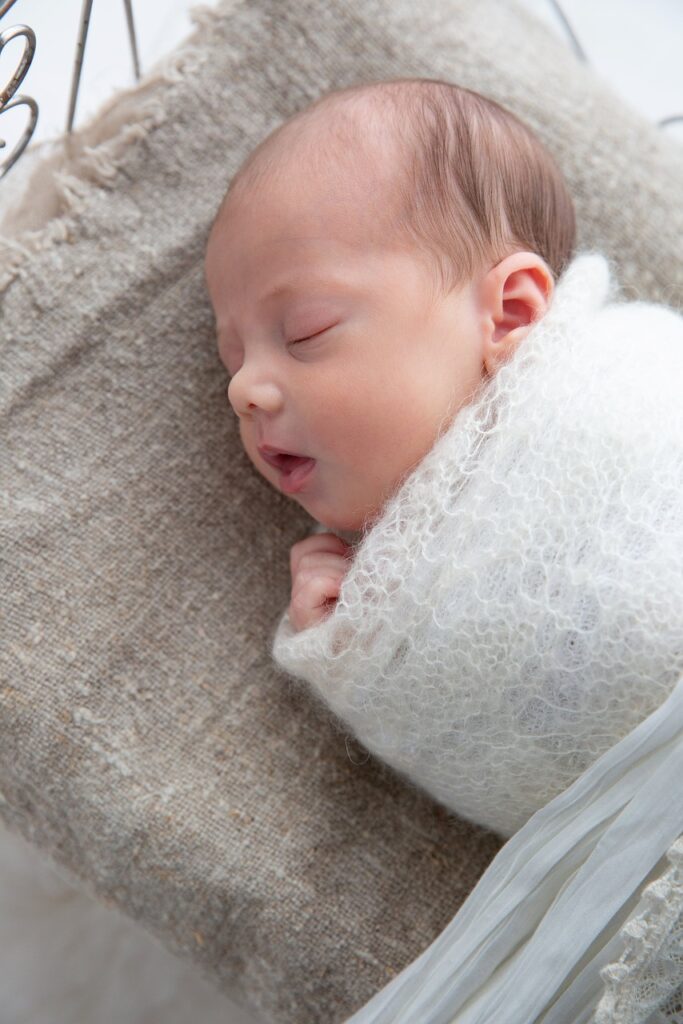
Starting sleep training at the right time can significantly improve your child’s sleep habits—and your own rest, too. But sleep training isn’t one-size-fits-all. The ideal time to begin depends on your baby’s age, developmental stage, and current sleep schedule. In this blog post, we’ll explore age-appropriate sleep training strategies, help you understand your child’s natural sleep patterns, and guide you in creating a consistent bedtime routine that supports long-term sleep success.
Newborns (0-3 Months): Establishing Healthy Sleep Habits
Focus on Sleep Shaping, Not Sleep Training
Newborns naturally have irregular sleep patterns and require frequent feedings, especially during the first few months. Because their sleep cycles are still developing, traditional sleep training methods aren’t recommended at this stage. Instead, this is the perfect time to focus on gentle sleep shaping—laying the foundation for healthy sleep habits through consistent routines, calming sleep environments, and age-appropriate wake windows.
-
- Create a Soothing Environment: Use white noise, dim lighting, and a comfortable sleep space.
-
- Establish a Routine: Start introducing a consistent sleep routine to signal that it’s time to sleep, even if the routine is very basic.
Preparing for Future Sleep Training
-
- Observe Sleep Patterns: Track your baby’s sleep patterns to identify any irregularities that may need addressing later.
-
- Consult with Your Pediatrician: Get advice on when to start more structured sleep training based on your baby’s development.
Infants (4-6 Months): Introducing Basic Sleep Training
Ideal Age for Starting Sleep Training: When Your Baby Is Ready for a Sleep Schedule
Most babies are developmentally ready to begin sleep training between 4 to 6 months of age. At this stage, many infants can sleep for longer stretches at night and start learning how to self-soothe. It’s also an ideal time to begin getting your baby on a consistent sleep schedule, which plays a key role in successful sleep training. Establishing regular nap times and bedtime routines during this window helps promote healthy sleep habits that can last well into toddlerhood.
-
- Gentle Sleep Training Methods: There are a variety of approaches to choose from, that focus on helping your baby learn to fall asleep independently while still offering comfort and support throughout the process.
-
- Establish Consistent Routines: Implement a bedtime routine that includes calming activities and consistent sleep times.
Addressing Common Issues
-
- Night Wakings: Begin to address frequent night wakings by teaching your baby to fall back asleep independently.
-
- Sleep Associations: Gradually reduce reliance on sleep associations such as feeding or rocking to sleep.
Older Infants (7-12 Months): Refining Sleep Training Techniques
Building on Established Routines
By the time your baby reaches 7 to 12 months, their sleep patterns are more consistent, and they’re capable of sleeping through the night with fewer feedings. This makes it an ideal time to refine and reinforce sleep training techniques you may have already introduced. At this stage, babies can better adapt to structured sleep schedules, and they’re more capable of learning consistent bedtime cues and self-soothing strategies. It’s also a great opportunity to address any lingering sleep disruptions—like frequent night wakings or short naps—and help your baby settle into a reliable, long-term sleep routine.
Advanced Sleep Training Strategies
-
- Sleep Training Methods: Your baby is more emotionally and physically equipped to handle sleep training, making it a great time to explore different sleep training methods that align with your parenting style and your baby’s temperament. Whether you prefer a more structured approach or a gentler, more gradual method, the key is consistency and responsiveness.
-
- Consistency is Key: Maintain consistency with your bedtime routine and sleep environment to reinforce good sleep habits.
Managing Developmental Changes
-
- Sleep Regressions: Be prepared for potential sleep regressions due to developmental milestones such as crawling or walking. Adjust your strategies as needed to address these changes.
Toddlers (12+ Months): Supporting Continued Sleep Independence
Addressing Sleep Challenges
As children transition into toddlerhood (around 12–36 months), their sleep habits can shift significantly. While they may already have an established sleep foundation, new challenges often emerge—such as separation anxiety, bedtime resistance, fear of the dark, or a sudden desire for more independence. These developmental changes can lead to bedtime battles, frequent night wakings, or early morning wakeups. Continue to support their sleep independence with age-appropriate strategies.
Reinforcing Good Sleep Habits
-
- Solidify Routine: Ensure that bedtime routines are consistent and reassuring.
-
- Encourage Self-Sleep Skills: Continue to promote self-soothing and independent sleep by gradually reducing your involvement at bedtime.
Handling Transition Periods
-
- Naps and Bedtimes: Adjust nap times and bedtimes as needed to accommodate changes in your toddler’s sleep needs.
What Next?
Not sure when to start sleep training or which methods to use? Contact me for personalized advice and support to create a sleep training plan that suits your child’s age and needs.
